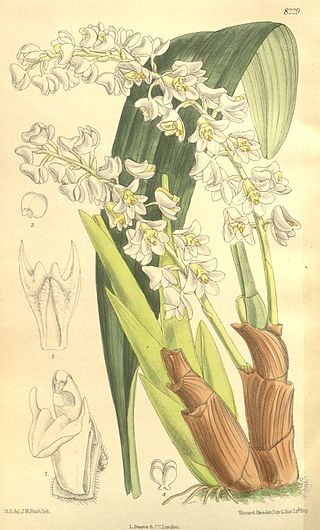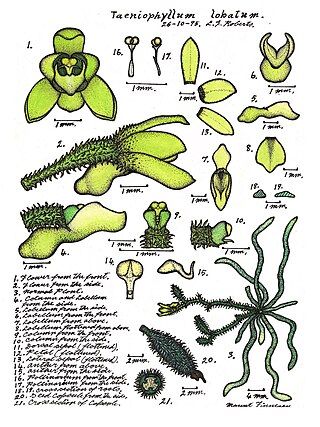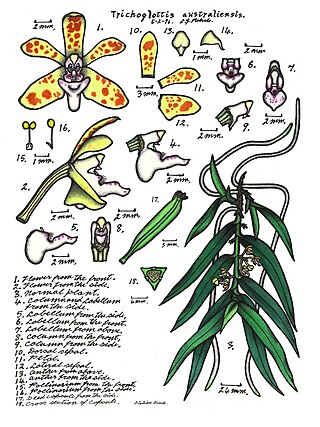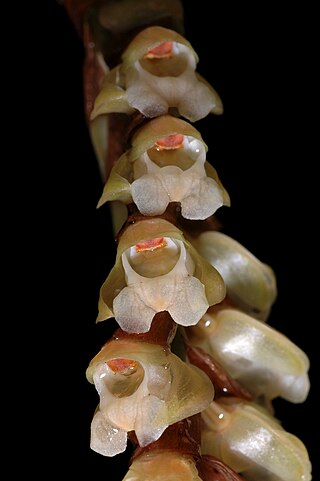
Bryobium, commonly known as urchin orchids or 藓兰属 , is a genus of flowering plants in the family Orchidaceae. Orchids in this genus are epiphytic or lithophytic plants with large, fleshy pseudobulbs, each with up to three leathery leaves and small, often hairy flowers. These orchids are found from tropical Asia to northern Australia.

Bulbophyllum elisae, commonly known as the pineapple orchid, is a species of epiphytic or lithophytic orchid that is endemic to eastern Australia. It has crowded, wrinkled, pale green or yellowish clump-forming pseudobulbs, stiff, pale green to yellowish leaves and between three and twelve pale green to dark green flowers with a dark red to purple labellum. It usually grows in the tops of rainforest trees, on cliff faces or boulders.
Bulbophyllum lageniforme, commonly known as the smooth strand orchid, is a species of epiphytic or lithophytic orchid that is endemic to tropical North Queensland. It has flattened, pale green, grooved, clump-forming pseudobulbs, stiff, dark green leaves and up to four cream-coloured or pale green flowers with a pink labellum. It usually grows on shrubs, trees and rocks in highland rainforest.
Bulbophyllum lilianae, commonly known as the warty strand orchid, is a species of epiphytic or lithophytic orchid that is endemic to tropical North Queensland. It has widely spaced, deeply grooved, dark green to yellowish pseudobulbs, thin but tough, dark green to yellowish leaves and up to three cream-coloured, pale green or reddish flowers with dark red stripes and a pink labellum. It grows on shrubs, trees and rocks, often in exposed situations.

Podochilus australiensis, commonly known as the native stream orchid, is a species of epiphytic or lithophytic orchid. It has a fern-like appearance with many thin, twisted, glossy green leaves and clusters of up to six dull white or greenish flowers with a green labellum. It grows tropical North Queensland.
Drymoanthus minutus, commonly known as green midget orchid, is a species of epiphytic or lithophytic orchid that forms small clumps with many thick roots emerging from a thin, erect stem. Between two and five dark green, leathery leaves are arranged along the stem and up to seven minute green to yellowish, star-shaped flowers are arranged on a stiff flowering stem. The sepals and petals are similar to each other and there is a fleshy white, unlobed labellum. This orchid occurs in northern Queensland where it grows in rainforest, usually at higher altitudes.

Robiquetia gracilistipes, commonly known as the large pouched orchid, is an epiphytic or lithophytic orchid from the family Orchidaceae that forms large, hanging, straggly clumps. It has long, thick, roots, a single stem, many thick, leathery leaves and up to forty cream-coloured, pale green or brownish flowers with red spots and a three-lobed labellum. It grows on trees and rocks in rainforest, usually in bright light. It is found in Malesia including New Guinea, the Solomon Islands and tropical North Queensland, Australia.

Taeniophyllum lobatum, commonly known as the yellow ribbonroot, is a species of leafless epiphytic or lithophytic orchid that forms small clumps. It has short stems, flattened pale to greyish green roots pressed against the substrate on which it is growing and usually two pale to bright yellow flowers. It only occurs in tropical North Queensland.

Thrixspermum congestum, commonly known as the cupped hairseed, is an epiphytic or lithophytic orchid that forms small clumps with many thin roots, up to fifteen leathery leaves and many star-shaped white or cream-coloured flowers. This orchid occurs from Papuasia to northern Australia.

Trachoma stellatum, commonly known as the starry spectral orchid, is an epiphytic or lithophytic clump-forming orchid with many thick roots. It has between three and eight thick, leathery leaves and many short-lived, cream-coloured flowers with purple markings and a yellow-tipped labellum. This orchid occurs in tropical North Queensland.
Trachoma papuanum, commonly known as the yellow spectral orchid, is an epiphytic or lithophytic clump-forming orchid with a between three and six thick, fleshy leaves and many dull yellow flowers with a white labellum opening in groups of up to four. This orchid occurs in New Guinea, Queensland and some islands in the South Pacific.

Trichoglottis australiensis, commonly known as the weeping cherub orchid, is an epiphytic or lithophytic clump-forming orchid. It has thick, cord-like roots, flattened, branching stems, many thick, leathery, glossy leaves and between two and six creamy yellow flowers with reddish blotches. This orchid only occurs in tropical North Queensland.
Bryobium dischorense, commonly known as the spotted urchin orchid, is an epiphytic or lithophytic clump-forming orchid that has fleshy, oval pseudobulbs, each with a single thin leaf and between four and eight cup-shaped, cream-coloured or whitish flowers with red spots. This orchid occurs in New Guinea and Queensland.
Bryobium eriaeoides, commonly known as brittle urchin orchid, is an epiphytic or lithophytic clump-forming orchid that has fleshy, green pseudobulbs, each with two leaves and between three and twelve cup-shaped white to purplish flowers but that sometimes remain closed. This orchid occurs in New Guinea and Queensland.
Bryobium irukandjianum, commonly known as small urchin orchid, is an epiphytic or lithophytic clump-forming orchid that has small, fleshy green pseudobulbs, each with two or three leaves and between seven and twelve small, short-lived, whitish to dull pink flowers. This orchid only occurs in tropical North Queensland.
Bryobium retusum, commonly known as Christmas Island urchin orchid, is an epiphytic clump-forming orchid that has oval, fleshy green pseudobulbs, each with two leaves and between seven and twelve short-lived, self-pollinating, pale green, hairy flowers. This orchid is found between Java and New Caledonia.
Liparis bracteata, commonly known as the yellow sphinx orchid, is a plant in the orchid family. It is an epiphytic or lithophytic orchid with cone-shaped pseudobulbs, each with two linear to lance-shaped leaves and between seven and twelve star-shaped pale green flowers that turn yellow as they age. This orchid grows on trees and rocks in rainforest in tropical North Queensland.

Liparis condylobulbon, commonly known as the tapered sphinx orchid or 细茎羊耳蒜 is a plant in the orchid family. It is an epiphytic or lithophytic orchid with crowded, glossy green, cylinder-shaped pseudobulbs, each with two linear to lance-shaped leaves and between fifteen and thirty five pale green to cream-coloured flowers with an orange labellum. This orchid usually grows on trees and rocks in rainforest from Taiwan and Indochina to the south-west Pacific.

Pholidota imbricata, commonly known as the common rattlesnake orchid or necklace orchid, is a plant in the orchid family and is a clump-forming epiphyte or lithophyte with crowded pseudobulbs. Each pseudobulb has a single pleated, leathery leaf and up to sixty white, cream-coloured or greenish, cup-shaped flowers in two ranks along a wiry flowering stem. There is a large, papery bract at the base of each flower. This species is native to areas from tropical and subtropical Asia to the southwest Pacific.
Pinalia moluccana, synonym Eria kingii, commonly known as the common gremlin orchid, is a plant in the orchid family and is an epiphyte or lithophyte with crowded pseudobulbs, each with three or four thin, channelled leaves. Up to fifty white or cream-coloured, cup-shaped flowers with hairy exteriors are arranged along an erect flowering stem. It is native to areas between Sulawesi and tropical North Queensland.










